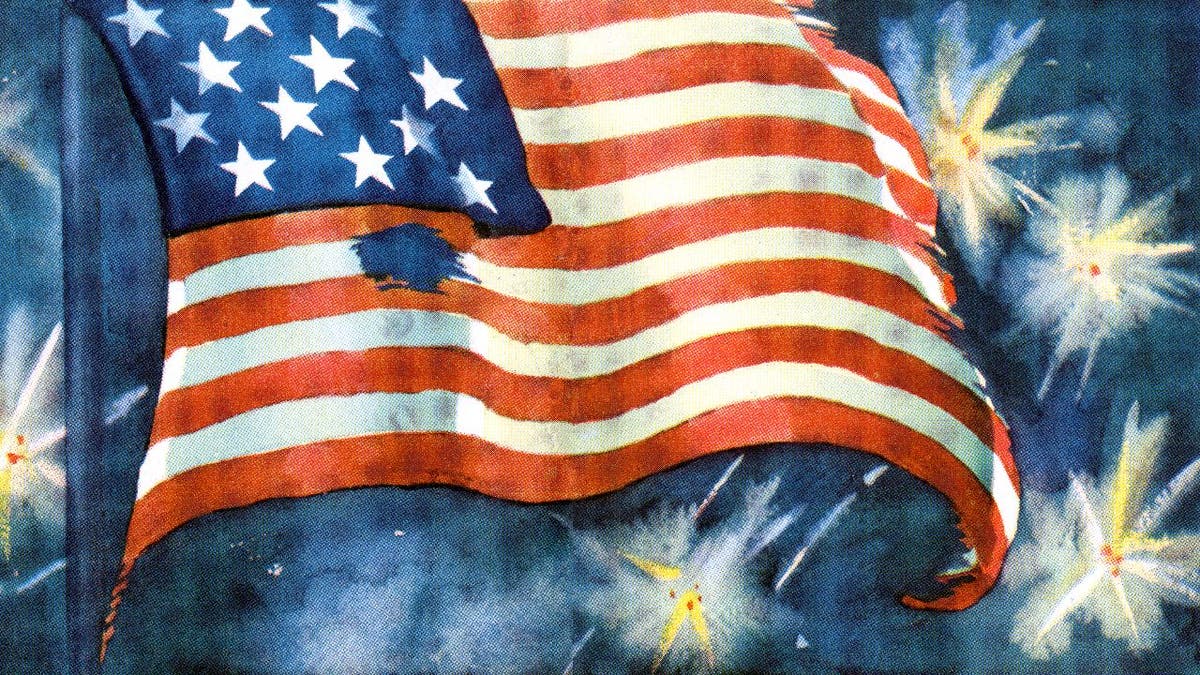Wisconsin company creates American flags made out of wood, steel
Metal Art of Wisconsin founder Shane Henderson joined 'Fox & Friends' to discuss how the flags are made this Fourth of July.
Francis Scott Key awoke aboard a British warship after watching the terrifying 25-hour bombardment of Fort McHenry — and, by dawn's early light, was stunned to find that our flag was still there on this day in history, Sept. 14, 1814.
The Baltimore attorney, in a fit of patriotic fervor after witnessing the relentless naval attack on his American homeland, soon put pen to paper and feverishly scribbled down his poetic account of the event.
We know his words today as our national anthem.
"The rocket's red glare, the bomb bursting in air/Gave proof through the night that our flag was still there," Key wrote over the next two days.
"O say does that star-spangled banner yet wave/O'er the land of the free and the home of the brave."

This screen print illustration from 1941 depicts an American flag flying over Fort McHenry, based on Francis Scott Key's national anthem, "The Star-Spangled Banner." (GraphicaArtis/Getty Images)
Key was stirred by the resolve of his fellow Americans as the young republic faced despair in the War of 1812 and possible defeat at the hands of the British Empire.
The United States was humiliated just three weeks earlier when British troops ransacked and torched Washington, D.C., destroying in a fiery blaze much of both the White House and the Capitol.
ON THIS DAY IN HISTORY, SEPTEMBER 13, 1857, MILK CHOCOLATE MAGNATE MILTON HERSHEY BORN IN PA
Key was certain that American defenses at Fort McHenry, just 40 miles from the nation’s capital, would collapse under the attack's intensity.
"Mother earth … was vomiting shot and shell in a sheet of fire and brimstone." — Francis Scott Key
"Superior British weapons pounded the fort from newly designed bomb ships anchored safely out of range of the fort’s own guns," the National Constitution Center wrote of the empire’s firepower.
ON THIS DAY IN HISTORY, AUGUST 24, 1814, BRITISH TROOPS RANSACKED, TORCHED WHITE HOUSE AND CAPITOL
"It seemed as though mother earth had opened and was vomiting shot and shell in a sheet of fire and brimstone," Key later wrote.
The impossibility of the fort’s survival — and the nation’s fiery refusal in its weakest moment to bend to the British — fueled Key’s profound patriotic response.

Oil on panel portrait of Francis Scott Key (fragment). Attributed to Joseph Wood (1778-1830). Collection of the Walters Art Museum. (Public Domain)
"His brother-in-law, commander of a militia at Fort McHenry, read Key's work and had it distributed under the name ‘Defence of Fort M'Henry," Smithsonian Magazine reported in a 2007 account of the Battle of Baltimore.
"The Baltimore Patriot newspaper soon printed it, and within weeks, Key's poem, now called ‘The Star-Spangled Banner,’ appeared in print across the country, immortalizing his words — and forever naming the flag it celebrated."
Key's poem became the national anthem by an Act of Congress that President Herbert Hoover signed in 1931.
"The rocket's red glare/The bombs bursting in air/Gave proof through the night/That our flag was still there."
The actual flag raised over Fort McHenry by the dawn’s early light on Sept. 14 enjoys a place of honor today at the National Museum of American History in Washington, D.C.
It’s known as the Great Garrison Flag.
ON 9/11 ANNIVERSARY, FAITH LEADERS NATIONWIDE OFFER PRAYERS, COMFORT AND HOPE FOR OUR COUNTRY
The fort’s star-spangled banner measured 42 feet by 30 feet and had 15 stars and 15 stripes.
It was the custom in the very early days of the nation to add both a star and a stripe with the addition of each new state to the Union.

The Star-Spangled Banner flag or the Great Garrison Flag — the flag that flew over Fort McHenry in 1814 and inspired Francis Scott Key; screen print, 1926. (Photo by GraphicaArtis/Getty Images)
Maj. George Armistead, commander of Fort McHenry, had requested that a giant flag be made to fly over the fort a year earlier, with the War of 1812 well underway and certain at some point he would come under attack.
"The job went out to a 37-year-old widow, Mary Pickersgill, a ship and signal flag maker," said the National Park Service of the Great Garrison Flag's history.
CLICK HERE TO SIGN UP FOR OUR LIFESTYLE NEWSLETTER
"She labored for seven weeks with her 13-year-old daughter, Caroline, two nieces, 13-year-old Eliza Young and 15-year-old Margaret Young, a 13-year-old African American indentured servant, Grace Wisher, and possibly her mother, Rebecca Young, who had taught her the trade."
The state of Maryland honors the defense of Fort McHenry with Defenders Day each Sept. 12.
The NPS continued, "They pieced together strips of loosely woven English wool bunting, then laid the whole flag out on the expansive floor of a brewery near Mrs. Pickersgill’s Pratt Street house, now the Star-Spangled Banner Flag House Museum."
A smaller flag that flew over the fort during the bombardment has been lost to history, according to the NPS.
For more Lifestyle articles, visit www.foxnews.com/lifestyle
Fort McHenry today enjoys a special status not only as a national monument but as a U.S. historic shrine.
CLICK HERE TO GET THE FOX NEWS APP
The state of Maryland honors the defense of Fort McHenry with Defenders Day each Sept. 12.





















